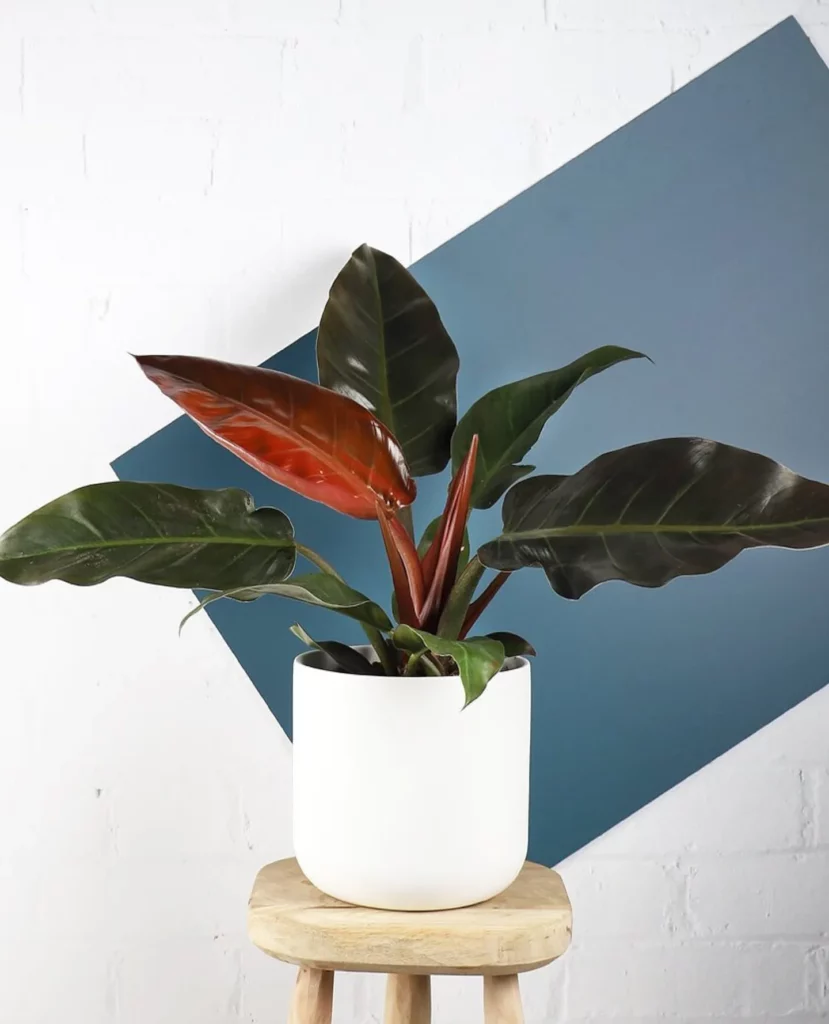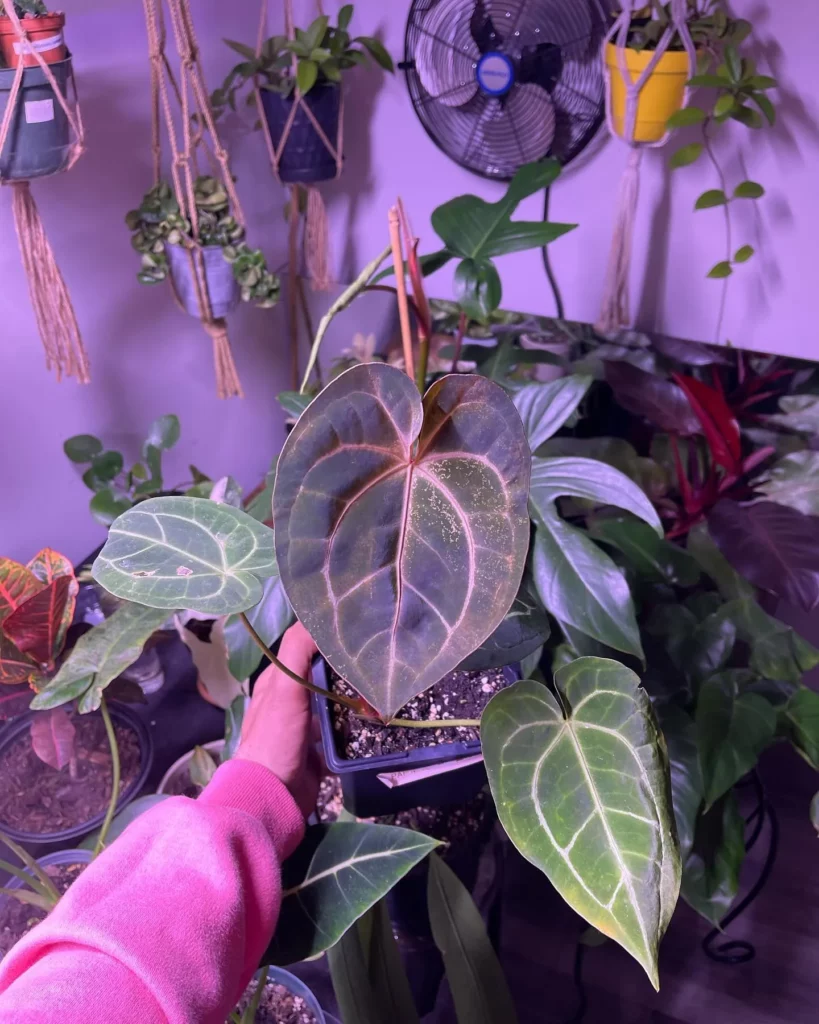To accelerate Philodendron growth, ensure it receives ample indirect sunlight, maintains consistent moisture levels, and is fertilized regularly during the growing season.
Philodendrons are beloved houseplants known for their stunning foliage and easy care, yet some struggle to achieve rapid growth. However, with proper attention and care, your philodendron can thrive and grow faster. Caring for a philodendron is straightforward, involving considerations like light, water, soil quality, and nutrients. Sadly, some neglect these essential factors due to lack of knowledge or effort. To witness your philodendron flourishing and growing faster, a little effort is necessary, and the results will undoubtedly be rewarding.
Lighting



Let’s start with lighting – arguably one of the most important factors in determining how quickly your philodendron grows. Philodendrons are relatively low-light plants that prefer bright but indirect sunlight – meaning they should not be placed in direct sunlight for extended periods of time. If you’re struggling with getting your plant enough light or providing the right kind of light source altogether, then consider investing in a grow light specifically designed for plants like philodendrons.
No products found.
These lights mimic natural sunlight and can help encourage growth even when natural lighting is low. Remember – without sufficient light exposure, your philodendron won’t be able to photosynthesize properly which will slow down its overall growth rate significantly.
No products found.
Watering

Next up: watering. This might seem like a no-brainer for some people, but it’s worth repeating: over-watering can be just as detrimental to your philodendron’s growth as under-watering. In general, philodendrons prefer slightly moist soil – not completely waterlogged or bone dry.
One easy trick to make sure you’re watering your plant correctly is to wait until the top inch of soil is dry before watering again. This will help prevent over-watering while still providing ample moisture for healthy growth.
Another thing to keep in mind when watering your philodendron is the type of water you’re using. Tap water can contain harmful minerals and chemicals that can harm your plant over time – so consider using filtered or distilled water instead.
No products found.
Soil



Moving on to soil quality – another important factor in determining how well your philodendron grows. Philodendrons prefer well-draining soil that retains some moisture without getting too soggy.
When choosing a soil mix for your plant, look for one that contains some organic material like peat moss or coconut coir which will help retain moisture in the soil while also providing important nutrients for growth. Additionally, don’t forget about adding nutrients back into the soil periodically by fertilizing- this will help nourish and promote faster growth in your plant.
Pruning

We have pruning – an often-overlooked aspect of caring for a philodendron (or any houseplant!). Pruning helps promote healthy growth by removing dead or damaged leaves and encouraging new growth from healthy stems. Don’t worry about harming your plant when pruning – it’s a natural part of its life cycle-just make sure you do it with clean tools.
No products found.
Prune only when necessary and never remove more than ⅓ of the foliage at once to avoid shocking the plant. By following these simple tips for lighting, watering, soil quality, and pruning- you can take care of your philodendron so that it grows faster than ever before!
The Popularity Of Philodendrons As Houseplants



Philodendrons have become increasingly popular as houseplants over the years due to their beautiful appearance and ease of care. They come in different shapes and sizes ranging from the small heart-leaf philodendron to the large split-leaf philodendron.
Their popularity has also been boosted by social media platforms like Instagram, where people showcase their #plantbabies. People love philodendrons because they can be displayed in various ways: on shelves, tabletops or even hanging baskets.
Their coloration ranges from deep green to golden yellow with some species possessing a marbled effect on their leaves. With such beauty they add a touch of elegance in any room.
Importance Of Proper Care And Maintenance For Optimal Growth

Philodendrons are often touted as low-maintenance plants but this is not entirely true if you want them to thrive. Proper care and maintenance are vital for optimal growth because they help ensure that your plant receives all essential requirements necessary for robust development.
To get started on proper care, you should consider factors such as lighting conditions, humidity levels, watering frequency and soil quality since these all affect how well your plant grows. You cannot just leave it unattended after planting it in soil; there is still a lot more to do if you want a fast-growing, healthy plant.
Let There Be Light: The Key To Philodendron Growth



Philodendrons are true sun worshippers, and if you’re not providing them with the right amount and type of light, you’re doing a huge disservice to your plant. Let’s start with the basics: light is the fuel for photosynthesis (the process by which plants convert light into energy), which means that without adequate lighting, your philodendron won’t be able to grow as fast or as well as it could.
And if you think that just any old light will do, think again. Philodendrons require specific wavelengths of light in order to maximize their growth potential.
So what kind of light should you be providing? First of all, natural sunlight is always preferred over artificial lighting.
If at all possible, place your philodendron near a window where it can receive bright but indirect sunlight for several hours each day. If natural sunlight isn’t an option (for example, if your home doesn’t receive much direct sunlight), then you’ll need to invest in some artificial lighting.
No products found.
When it comes to artificial lighting options for plants like philodendrons, there are two main types: fluorescent and LED lights. Fluorescent lights have been used for indoor plant growth for decades and are relatively inexpensive and widely available.
However, they don’t provide as much PAR (photosynthetically active radiation) as LED lights do, which means that your plant may not grow quite as quickly or robustly under fluorescent lighting. On the other hand, LED lights are more expensive but offer several advantages over fluorescent lights when it comes to growing plants indoors.
For one thing, LEDs emit specific wavelengths of light that are ideal for photosynthesis (including both red and blue wavelengths). They also produce less heat than fluorescent lights and last longer overall.
How Much Light Do Philodendrons Need?
Now that you know what type of light to provide, the next question is: how much light do philodendrons need? The answer is a bit more complicated than just “lots.” In general, philodendrons grow best with bright but indirect sunlight for at least six hours each day. However, too much direct sunlight can scorch their leaves, so it’s important to strike the right balance.
If you’re not sure whether your plant is getting enough light, here are some signs to look for: yellowing or browning leaves, slow growth, and an overall droopy or wilted appearance. On the other hand, if your plant is getting too much light, you might notice burnt or crispy leaf tips and edges.
Providing Adequate Lighting
So how can you make sure that your philodendron is getting enough light without overdoing it? Here are some tips: – Place your plant near a window that receives bright but indirect sunlight for at least six hours each day.
If natural sunlight isn’t an option (for example, if you live in a basement apartment), invest in some LED grow lights. – Make sure that your plant isn’t getting too much direct sunlight (which can lead to burnt leaves) by using sheer curtains or blinds to filter the light.
Rotate your philodendron periodically so that all sides of the plant receive equal amounts of light. By following these guidelines and paying close attention to your plant’s response to its environment, you should be able to provide adequate lighting for optimal philodendron growth.
Watering: The Key To Philodendron Growth

Philodendrons are beautiful plants that can add a touch of greenery and life to any room. However, they can also be quite finicky when it comes to watering.
Many people make the mistake of overwatering their philodendron, which can lead to root rot and ultimately kill the plant. On the other hand, underwatering can cause the leaves to wilt and turn brown.
So, how much water does your philodendron really need? Let’s dive in.
No products found.
The Importance Of Proper Watering Techniques
Proper watering techniques are crucial for the growth and survival of your philodendron. This is because water is essential for photosynthesis – the process by which plants convert light energy into food. Without enough water, your philodendron will not be able to produce enough food to support its growth.
Insinuating That Many People May Not Know How Much Water Their Philodendron Needs Or When To Water It
It’s no secret that many people struggle with knowing how much water their philodendron needs or when to water it. Some may believe that watering once a day is necessary for optimal growth, while others may think that watering once a week is sufficient. The truth is, there is no one-size-fits-all answer when it comes to watering frequency.
Tips On How To Properly Water Your Plant, Including Frequency And Amount
So, how do you know when it’s time to water your philodendron? One way is by checking the soil moisture level.
Stick your finger about an inch into the soil – if it feels dry, it’s time to water. If it still feels moist, wait a few more days before checking again.
When you do water your plant, make sure to water thoroughly. Water until it drains out the bottom of the pot, and then discard any excess water.
This will help prevent root rot caused by standing water. In terms of frequency, it’s better to underwater than overwater.
Aim to water your philodendron once every 7-10 days, depending on the humidity levels in your home and the size of your pot. Remember, it’s always better to err on the side of caution when it comes to watering – you can always add more water if needed, but you can’t take it away once you’ve overwatered.
The Dirt On Soil



Explaining The Significance Of Soil Quality In Plant Growth
When it comes to plant growth, soil quality is everything. A good soil mix can provide the necessary nutrients and structure for a plant to thrive, while a poor soil mix can result in stunted growth or even death.
It’s important to understand that not all soils are created equal. The ideal soil for philodendrons is one that is well-draining and contains plenty of organic matter.
This type of soil allows for proper root development and helps prevent waterlogged conditions that can lead to disease or pest problems. Additionally, good quality soil has the capacity to hold moisture and nutrients, providing a steady supply of both for optimal growth.
Insinuating That Some People May Not Know What Type Of Soil Is Best For Philodendrons
Unfortunately, many people don’t know what type of soil is best for their philodendrons. They may opt for cheap potting mixes that lack the necessary ingredients or don’t provide adequate drainage. Others may simply use whatever they have on hand without considering whether it’s suitable for their plants.
This lack of knowledge can have serious consequences for the health and growth of your philodendron. Without proper drainage, excess water can cause root rot or other fungal diseases, while nutrient-poor soils can lead to deficiencies and slower growth rates.
Tips On Choosing The Right Soil Mix

To ensure your philodendron grows as quickly as possible (and stays healthy), you’ll need to choose the right type of soil mix. Look for a blend that contains peat moss or coconut coir as a base, along with perlite or vermiculite to improve drainage.
You may also consider adding additional organic matter such as compost or worm castings for extra nutrients. These additives can help improve soil structure and fertility, providing a boost to your philodendron’s growth rate.
No products found.
Adding Nutrients For Faster Growth
In addition to choosing the right soil mix, it’s important to provide your philodendron with adequate nutrients for optimal growth. While many potting mixes contain some basic fertilizers, these may not be enough to support rapid plant development.
Consider using a slow-release fertilizer or organic options like fish emulsion or seaweed extract. These products are designed to provide a steady supply of nutrients over time, helping your philodendron grow faster and stronger.
Remember that soil quality is one of the most important factors in plant growth. By choosing the right mix and providing adequate nutrients, you can ensure that your philodendron thrives and reaches its full potential.
The Power Of Fertilizing Your Philodendron



Fertilizing your philodendron is absolutely crucial if you want to see it grow faster and stronger. Some people may not realize this, but your plant needs nutrients in order to thrive.
Sure, it may look fine without fertilizer, but it won’t reach its full potential. Think of it like feeding yourself junk food instead of healthy meals – you’ll survive, but you won’t be as healthy or energized as you could be.
Insinuating That Some People May Not Know When Or How Often To Fertilize Their Plant
It’s shocking how many people don’t know when or how often to fertilize their philodendron! First off, you should only fertilize during the growing season (spring/summer).
Secondly, different types of fertilizer have different schedules – some need to be applied every 2 weeks while others only once a month. It’s important to read the instructions on your specific fertilizer so you can give your plant the proper care.
So why do some people fail to fertilize properly? It could be because they don’t know any better, or they think that watering is enough.
But let me tell you – watering alone won’t provide enough nutrients for growth. And if you’ve invested in a beautiful philodendron plant, why not give it the best chance at success?
Tips On Choosing The Right Fertilizer And Schedule For Optimal Growth
Choosing the right fertilizer can be overwhelming with so many options available. But don’t worry – I’ve got some tips for you! Look for a balanced fertilizer with equal amounts of nitrogen (N), phosphorus (P), and potassium (K).
A ratio of 10-10-10 or 20-20-20 will work well. As for schedule, again it varies depending on the type of fertilizer.
But a general rule of thumb is to fertilize once every 2-4 weeks during the growing season. Be sure to dilute the fertilizer in water before applying – too much can burn your plant’s roots.
No products found.
Don’t forget to also adjust your schedule based on the health and growth rate of your individual plant. If it looks like it needs more nutrients, increase your frequency slightly.
And always water your philodendron thoroughly before fertilizing to prevent root burn. Fertilizing is a critical step in achieving optimal growth for your philodendron plant.
Pruning: The Secret To Philodendron Growth

Philodendrons are a beautiful addition to any home, but many people don’t realize that pruning is crucial for optimal growth. Some may be hesitant to prune their plant because they fear they will damage it, but in reality, pruning is one of the best things you can do for your philodendron. Here’s why:
Why Pruning Is Important
Pruning stimulates new growth. By removing dead or yellowed leaves, your philodendron can focus its energy on producing new foliage and roots. Additionally, pruning helps control the size and shape of your plant.
Without pruning, your philodendron may become too large or unruly for its space. But don’t just chop away at your philodendron without caution – there’s a method to the madness.
When And How To Prune Your Philodendron
The best time to prune your philodendron is in the spring or summer when it’s actively growing. Use clean, sharp scissors or shears to make a clean cut just above a node (where a leaf meets the stem).
If you’re unsure about where to make the cut, start small and work your way up. Remember that less is often more when it comes to pruning – cutting too much at once can shock your plant and slow down its growth.
No products found.
Tips For Safe Pruning
Be sure not to remove more than 30% of your plant’s foliage at one time as this could severely harm it. Always use sterilized cutting tools by wiping them down with alcohol before use; this minimizes exposure of cuts made into open wounds on plants from bacterial contaminants that could lead them away from growth.
Trimming lower leaves near the soil line first will direct energy towards newer leaves and encourage the plant to grow upward as a result. If you want to control the shape of your philodendron, pinch back new growth at the tips of stems to encourage bushier growth.
Pruning is not only important for maintaining a healthy and attractive philodendron, but it’s also essential for promoting faster growth. Don’t be afraid to get your hands dirty and give your plant some TLC – with proper care and pruning techniques, your philodendron will thrive.
After reading this, check out our other articles on:
Conclusion: Growing A Green Thumb



Growing a philodendron can be a rewarding experience that requires proper care and maintenance. By following the tips provided in this article, anyone can make their philodendron grow faster and healthier. It’s important to remember that plants are living organisms that require attention and care just like any other living being.
Lighting: Shed Some Light On The Situation
When it comes to lighting, it’s important to understand the importance of photosynthesis in plant growth. Philodendrons need adequate light to thrive, but too much or too little can have detrimental effects.
Natural light is always the best option, but artificial lighting can also be used to supplement or replace natural light if necessary. Remember to check your plant for signs of stress or damage due to inadequate lighting.
Watering: Don’t Drown Your Plant
Proper watering techniques are crucial for philodendron growth. Overwatering can lead to root rot and under-watering can cause drought stress.
The key is finding the right balance by checking the soil moisture regularly and adjusting watering frequency accordingly. Adding drainage holes in your pot or using a well-draining soil mix will also help prevent waterlogging.
Soil: Laying Down Roots
Soil quality is another important factor in philodendron growth. Choosing the right soil mix with adequate nutrients will provide a healthy foundation for your plant’s roots to grow into. Adding additional nutrients through fertilization will also boost growth and overall health of your philodendron.
Fertilizing: Food For Thought
Fertilizing your philodendron is an easy way to provide additional nutrients for optimal growth. It’s important to choose the right fertilizer and schedule for your plant’s specific needs.
Too much fertilizer can lead to burning or other damage, while too little can result in stunted growth. Remember to always follow the instructions on the fertilizer label and adjust accordingly based on your plant’s response.
Pruning: Trim The Fat
Pruning is an essential part of philodendron care, as it helps promote new growth and prevent disease or pests from spreading. It’s important to know when and how to prune your plant without causing harm.
Always use clean tools and cut at a 45-degree angle just above a node or leaf. Growing a philodendron can be a fulfilling experience that requires patience, attention, and care.
By following the tips provided in this article on lighting, watering techniques, soil quality, fertilizing, and pruning anyone can make their philodendron grow faster and healthier. With proper care, your green thumb will flourish!





